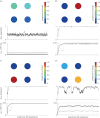Individual-level personality influences social foraging and collective behaviour in wild birds
- PMID: 24990682
- PMCID: PMC4100518
- DOI: 10.1098/rspb.2014.1016
Individual-level personality influences social foraging and collective behaviour in wild birds
Abstract
There is increasing evidence that animal groups can maintain coordinated behaviour and make collective decisions based on simple interaction rules. Effective collective action may be further facilitated by individual variation within groups, particularly through leader-follower polymorphisms. Recent studies have suggested that individual-level personality traits influence the degree to which individuals use social information, are attracted to conspecifics, or act as leaders/followers. However, evidence is equivocal and largely limited to laboratory studies. We use an automated data-collection system to conduct an experiment testing the relationship between personality and collective decision-making in the wild. First, we report that foraging flocks of great tits (Parus major) show strikingly synchronous behaviour. A predictive model of collective decision-making replicates patterns well, suggesting simple interaction rules are sufficient to explain the observed social behaviour. Second, within groups, individuals with more reactive personalities behave more collectively, moving to within-flock areas of higher density. By contrast, proactive individuals tend to move to and feed at spatial periphery of flocks. Finally, comparing alternative simulations of flocking with empirical data, we demonstrate that variation in personality promotes within-patch movement while maintaining group cohesion. Our results illustrate the importance of incorporating individual variability in models of social behaviour.
Keywords: Parus major; behavioural type; collective decision-making; group foraging; leader–follower; social information.
Figures



References
-
- Krause J, Ruxton GD. 2002. Living in groups. Oxford, UK: Oxford University Press.
Publication types
MeSH terms
Grants and funding
LinkOut - more resources
Full Text Sources
Other Literature Sources

